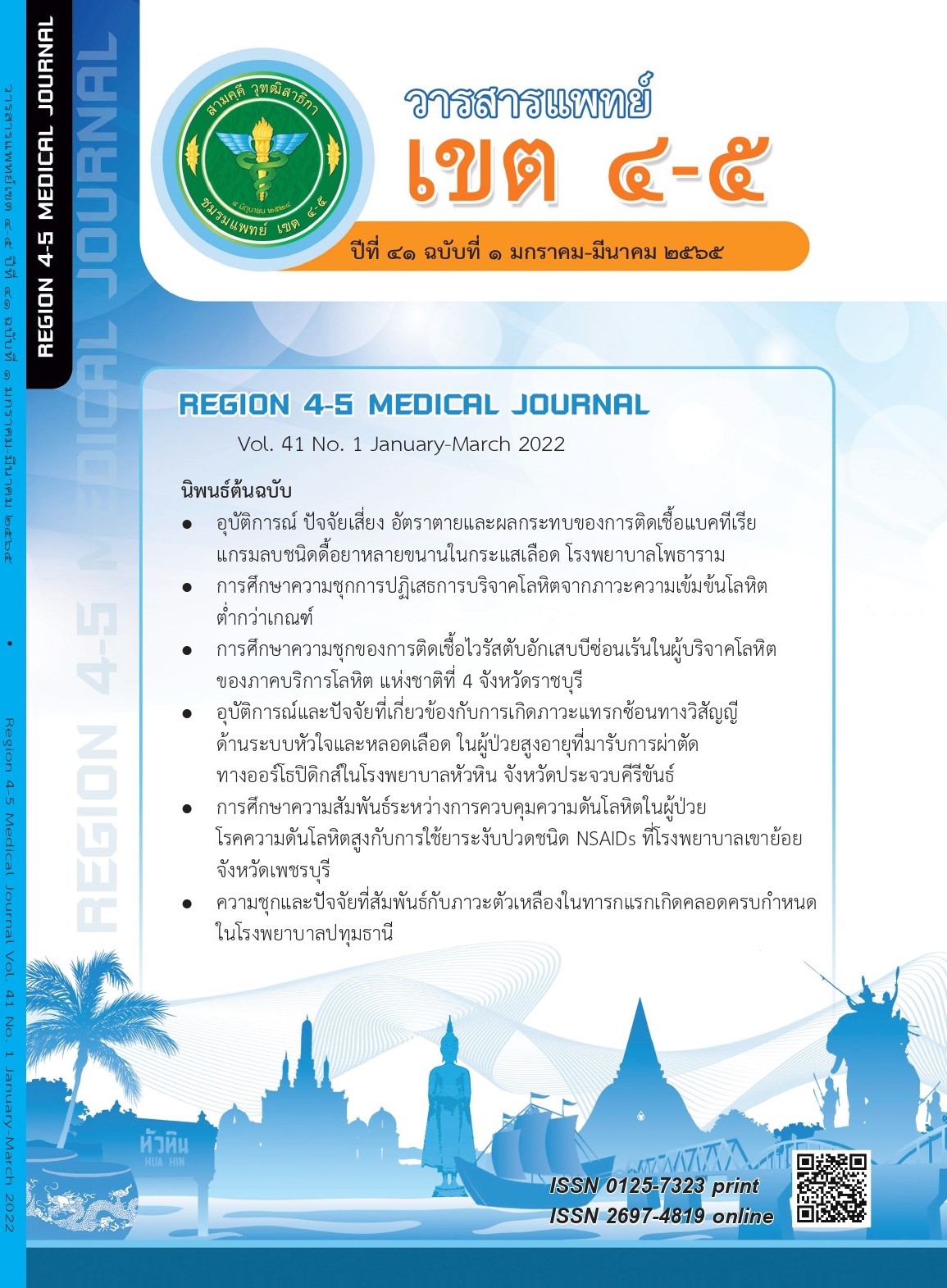การศึกษาความชุกของการติดเชื้อไวรัสตับอักเสบบีซ่อนเร้น ในผู้บริจาคโลหิตของภาคบริการโลหิตแห่งชาติที่ 4 จังหวัดราชบุรี
คำสำคัญ:
เชื้อไวรัสตับอักเสบบี, การติดเชื้อไวรัสตับอักเสบบีซ่อนเร้นบทคัดย่อ
วัตถุประสงค์: เพื่อศึกษาความชุกของการติดเชื้อไวรัสตับอักเสบบีซ่อนเร้น (occult hepatitis) ในผู้บริจาคโลหิตของภาคบริการโลหิตแห่งชาติที่ 4 จังหวัดราชบุรี
วิธีการศึกษา: เป็นการศึกษาโดยรวบรวมข้อมูลผลการตรวจโลหิตจากผู้บริจาคโลหิตที่ให้ผลลบต่อ HBsAg แต่ให้ผลบวกต่อ HBV DNA และตรวจ HBV profile ตั้งแต่เดือนมกราคม พ.ศ. 2559 ถึง ธันวาคม พ.ศ. 2563
ผลการศึกษา: จำนวนผู้บริจาคโลหิตทั้งหมด 146,254 ราย พบผู้บริจาคโลหิตที่ให้ผลลบต่อ HBsAg แต่ให้ผลบวกต่อ HBV DNA จำนวน 133 ราย คิดเป็นอัตราส่วน 1 : 1,099 โดยผู้บริจาคโลหิตที่มีผลบวกต่อ anti-HBc อย่างเดียว 62 ราย (ร้อยละ 46.6) บริจาคโลหิตที่มีผลบวกต่อ anti-HBs อย่างเดียว 10 ราย (ร้อยละ 7.5) ผู้บริจาคโลหิตที่มีผลบวกต่อทั้ง anti-HBc และ anti-HBs 54 ราย (ร้อยละ 40.6) และผู้บริจาคโลหิตที่มีผลลบต่อทั้ง anti-HBc และ anti-HBs 7 ราย (ร้อยละ 5.3)
สรุป: การศึกษาวิจัยครั้งนี้ พบการติดเชื้อไวรัสตับอักเสบบีซ่อนเร้น โดยตรวจพบ HBV DNA ประมาณ 1 : 1,099 ซึ่งเป็นอัตราส่วนที่สูง ดังนั้นการตรวจหา HBV DNA ในการตรวจกรองโลหิตบริจาคสามารถลดความเสี่ยงของการติดเชื้อจากการรับโลหิตและส่วนประกอบโลหิตได้
เอกสารอ้างอิง
บุญเติม แสงดิษฐ, ชัยพล บัณฑิตสิงห์, ดุสิต จันทยานนท์. การติดเชื้อไวรัสตับอักเสบบีเรื้อรังในชายหนุ่มไทย: ปัญหาที่ควรได้รับการแก้ไข. เวชสารแพทย์ทหารบก 2557;67(2):79–84.
Custer B, Sullivan S, Thomas K, et al. Global epidemiology of hepatitis B virus. J Clin Gastroenterol. 2004;38(10 Suppl 3):158–68.
Merican I, Guan R, Amarapuka D, et al. Chronic hepatitis B virus infection in Asian countries. J Gastroenterol Hepatol 2000;15(12):1356–61
Charline L, Pierrick A, Khamduang W, et al. Prevalence of chronic hepatitis B virus infection in Thailand: a systematic review and meta-analysis. International J of Infectious Dis 2016;51:136–43.
ศูนย์บริการโลหิตแห่งชาติ สภากาชาดไทย. นโยบายบริการโลหิตแห่งชาติ พ.ศ. 2553. นนทบุรี: กรมควบคุมโรค กระทรวงสาธารณสุข; 2553. หน้า 32.
Esposito A, Sabia C, Iannone C, et al. Occult hepatitis infection in transfusion medicine: screening policy and assessment of current use of anti-HBc testing. Transfusion Med Hemother 2017;44(4):263–72.
Reesink HW, Engelfriet P, Henn G, et al. Occult hepatitis B infection in blood donors. Vox Sang 2008;94(2):153–66
Satake M, Taira R, Yuki H, et al. Infectivity of blood components with low hepatitis B virus DNA levels identifi ed in a look back program. Transfusion 2007;47(7):1197–205.
Dickson RC, Everhart JE, Lake JR, et al. Transmission of hepatitis B by transplantation of livers from donors positive for antibody to hepatitis B core antigen. Gastroenterology 1997;113(5):1668–74.
Spreafico M, Berzuini A, Foglieni B, et al. Poor efficacy of nucleic acid testing in identifying occult HBV infection and consequences for safety of blood supply in Italy. J Hepatol 2015;63(5):1068–76.
Allain JP, Mihaljevic I, Gonzalez-Fraile MI, et al. Infectivity of blood products from donors with occult hepatitis B virus infection. Transfusion 2013;53(7):1405–15.
Taira R, Satake M, Momose S, et al. Residual risk of transfusion-transmitted hepatitis B virus (HBV) infection caused by blood components derived from donors with occult HBV infection in Japan. Transfusion 2013;53(7):1393–404.
Satake M, Taira R, Yugi H, et al. Infectivity of blood components with low hepatitis B virus DNA levels identified in a lookback program. Transfusion 2007;47(7):1197–205.
Seed C, Maloney R, Kiely P, et al. Blood Service Medical Services Lookback Team. Infectivity of blood components from donors with occult hepatitis B infection-Results from an Australian lookback programme. Vox Sang 2015;108(2):113–22.
นิภาพรรณ ลี้ตระกูล, ไพรจิตร ตานัน, ลัดดา ฟองสถิตย์กุล. การตรวจหา HBV profile ในระยะ occult HBV infection ในผู้บริจาคโลหิตของโรงพยาบาลมหาราชนครเชียงใหม่. วารสารเทคนิคการแพทย์เชียงใหม่ 2556;46(1):72–80.
Pikulsod S, Oota S, Tirawatnapong T, et al. One-year experience of nucleic acid technology testing for human immunodefi ciency virus Type 1, hepatitis C virus, and hepatitis B virus in Thai blood donations. Transfusion 2009;49(6):1126–35.
Allain JP. Global epidemiology of occult HBV infection. Annals of Blood 2017;2(5):7.
Matsubara N, Kusano O, Sugamata Y, et al. A Novel Hepatitis B Virus Surface Antigen Immunoassay as Sensitive as Hepatitis B Virus Nucleic Acid Testing in Detecting Early Infection. Transfusion 2009;49(3):585–94.
Louisirirotchanakul S, Oota S, Khuponsarb K, et al. Occult hepatitis B virus infection in Thai blood donors. Transfusion 2011;51(7):1532–40.
Merat S, Rezvan H, Nouraie M, et al. The prevalence of hepatitis B surface antigen and anti-hepatitis B core antibody in Iran: a population-based study. Arch Iran
Med 2009;12(3):225–31.
Urbani S, Fagnoni F, Missale G, et al. The role of anti-core antibody response in the detection of occult hepatitis B virus infection. Clin Chem Lab Med 2010;48(1):23–9.
Hollinger FB. Hepatitis B virus infection and transfusion medicine:science and the occult. Transfusion 2008;48(5):1001–26.
ดาวน์โหลด
เผยแพร่แล้ว
รูปแบบการอ้างอิง
ฉบับ
ประเภทบทความ
สัญญาอนุญาต

อนุญาตภายใต้เงื่อนไข Creative Commons Attribution-NonCommercial-NoDerivatives 4.0 International License.
ลิขสิทธิ์บทความเป็นของผู้เขียนบทความ แต่หากผลงานของท่านได้รับการพิจารณาตีพิมพ์ลงวารสารแพทย์เขต 4-5 จะคงไว้ซึ่งสิทธิ์ในการตีพิมพ์ครั้งแรกด้วยเหตุที่บทความจะปรากฎในวารสารที่เข้าถึงได้ จึงอนุญาตให้นำบทความในวารสารไปใช้ประโยชน์ได้ในเชิงวิชาการโดยจำเป็นต้องมีการอ้างอิงถึงชื่อวารสารอย่างถูกต้อง แต่ไม่อนุญาตให้นำไปใช้ในเชิงพาณิชย์




